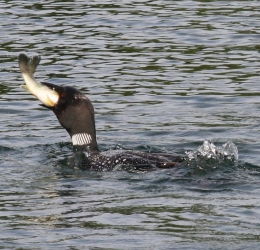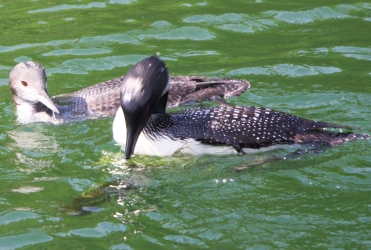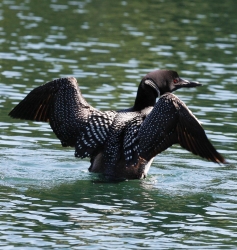  The eerie calls of the Loon echo across the clear lakes of northern Ontario and the United States with a sound you will never forget once you've heard it.
The eerie calls of the Loon echo across the clear lakes of northern Ontario and the United States with a sound you will never forget once you've heard it.
They can be very vocal and easy to locate, as the calls of one loon will often elicit a response from other loons on the lake.  Common loons are patterned in black and white. They are powerful, agile divers that can catch small fish in fast underwater chases. They come ashore only to nest. At up to 81 cm in length and weighing up to 5.5 kilograms, loons are large heavy birds that spend a lot of their time searching shallow waters for fish.
Common loons are patterned in black and white. They are powerful, agile divers that can catch small fish in fast underwater chases. They come ashore only to nest. At up to 81 cm in length and weighing up to 5.5 kilograms, loons are large heavy birds that spend a lot of their time searching shallow waters for fish.Swimming slowly and sticking their heads into the water, they will dive suddenly with a quick splash that hardly leaves a ripple on the water's surface, eventually to surface many metres away. The loon has sharp, rearward-pointing projections on the roof of its mouth and tongue that help it keep a firm hold on slippery fish. Loons have solid bones that make them less buoyant, but better at diving. They can quickly blow air out of their lungs and flatten their feathers to expel air from within their plumage, so they can dive quickly and swim fast underwater. Once below the surface, the loon's heart rate slows down to conserve oxygen. Common Loons eat during the day, when they can best see the fish. Biologists estimate that loon parents and their 2 chicks can eat about a half-ton of fish over a 15-week period. Loons can fly well, but they need 30 metres or more for flapping their wings and running across the top of the water in order to gain enough speed for take-off. They can get stranded on a pond that is too small. Young loons are on their own after their parents leave to migrate south at about 12 weeks. The youngsters gather into flocks and make their own journey south a few weeks later. Once they reach their coastal ocean water destination, they stay there for the next two years. In the third year, young loons return north, although they may not breed for several more years.   Loons defend their territory by lifting their body upright in the water and flapping their wings vigorously. If you're canoeing and get too close to a loon you might witness this, along with their defensive call as the loon swims away. They can also be very noisy at night. Loons are monogamous, and pair bonds typically last about 5 years. If one year one of the mates doesnít return, the other will quickly pair up with another mate. Courtship consists of swimming in circles, and synchronous dives. If nesting is successful, loon chicks can be seen going for a ride around the lake on a parentís back.   Common Loons are excellent indicators of water quality, since they need crystal-clear lakes (that make it easier for them to see prey underwater) with abundant populations of small fish. Lakes with shallow inlets and islands are preferred, as they provide cover from predators while resting and nesting. They also require lakes with enough surface area for their flapping-and-running takeoffs across the water. Common Loons that migrate across North America find large lakes and rivers to move between on their way north and south. |